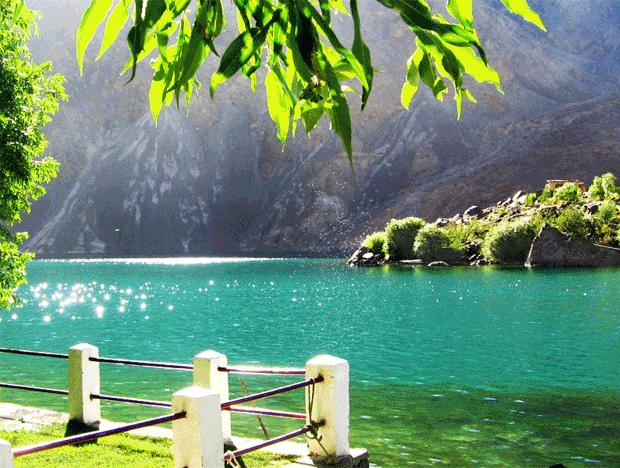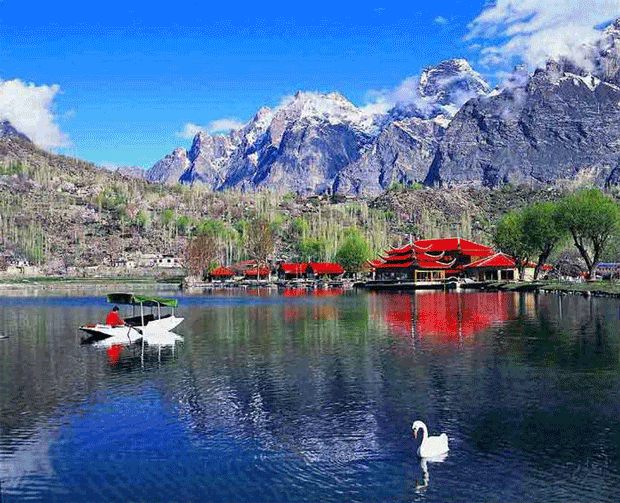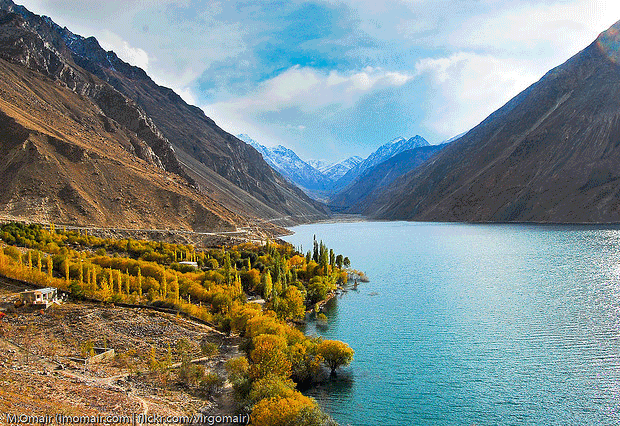|
Skardu is the main town of the region Baltistan and
the capital of Skardu District, one of the districts making up
Pakistan's Gilgit–Baltistan.
Skardu is located in the 10 km wide by 40 km long Skardu Valley, at the
confluence of the Indus river (flowing from near Kailash in Tibet and
through neighbouring Ladakh before reaching Baltistan) and the Shigar
River. Skardu is situated at an altitude of nearly 2,500 m (8,200 ft).
The town is surrounded by grey-brown coloured mountains, which hide the
8,000 metre peaks of the nearby Karakoram range.
|
|
 |
|
Skardu, along with Gilgit, are the two major tourism, trekking and
expedition hubs in Gilgit–Baltistan. The mountainous terrain of the
region, including four of the world's fourteen Eight-thousander peaks
(8,000 m and above), attracts the attention of tourists, trekkers and
mountaineers from around the world. The main tourist season is from
April to October; except this time period, the area can be cut off for
extended periods by the snowy, freezing winter weather.
Accessible from Skardu by road, the nearby Askole and Hushe are the main
gateways to the snow covered 8,000 m peaks including K2, the Gasherbrums,
Broad Peak and the Trango Towers, and also to the huge glaciers of
Baltoro, Biafo and Trango. This makes Skardu the main tourist and
mountaineering base in the area, which has led to the development of a
reasonably extensive tourist infrastructure including shops and hotels.
However, the popularity of the region results in high prices, especially
during the main trekking season.
Treks to the Deosai Plains, the second highest in the world (at 4,100 m
or 13,500 feet) after the Chang Tang in Tibet, either start from or end
at Skardu. In local Balti language, Deosai is called Byarsa, meaning
'summer place'. With an area of approximately 3,000 square kilometres,
the plains extend all the way to Ladakh and provide habitat for snow
leopards, ibex, Tibetan blue bears and wild horses. |
|

|
|
There are three lakes in the vicinity of Skardu. In local Balti-Tibetan
language, a lake is a thso or tso.
Kachura Lakes
There are two Kachura Lakes—the less well known Upper Kachura lake and
the more famous Lower Kachura Lake, better known as Shangrila Lake.
Lower Katsura lake is home to the Shangrila Resort hotel complex
(possibly the reason for the lake's alternative name), built in a
Chinese style and another popular destination for tourists in Pakistan.
The resort has a unique style of restaurant, set up inside the fuselage
of an aircraft that crashed nearby. Kachura lake 18m from Skardu.
Kachura Lake is famous for its deep blue waters. There are numerous
places to visit and things to do near Kachura Lake, situated near Skardu
in the northern area. |
|

|
|
Satpara Lake
Satpara Lake is Skardu Valley's main lake. In 2002, the Government of
Pakistan decided to build a dam on the Satpara Lake allocating $10
million to the Satpara Dam project, two years later in 2004. Progress on
the project has, however, been slow. Satpara Lake is 6 miles (9.7 km)
from Skardu. Satpara Lake is one of the largest fresh water lakes in the
countryside offering trout fishing, and row boating. This lake is also
the source of Skardu's drinking water.
Skardu Fort
Skardu Fort or Kharphocho Fort lies on the eastern face of the Khardrong
or Mindoq-Khar ("Castle of Queen Mindoq") hill 15 metres or 40 feet (12
m) above Skardu town. The fort dates from the 8th Century CE and
contains an old mosque probably dating back to the arrival of Islam in
the 16th Century CE. The fort provides a panoramic view of Skardu town,
the Skardu valley and the Indus River. The fort was built by Rmakpon
dynasty rulers of Baltistan and it was a seven storey building. |
|
 |
|
Kharphocho (Skardu) fort was built on a design similar to that of Leh
Palace and the Potala Palace in Lhasa, Tibet. The name Kharpochhe means
the great fort — Khar in Tibetan means castle or fort and Chhe means
great.
|
|
VIEW PICTURE GALLERY
|
|
|